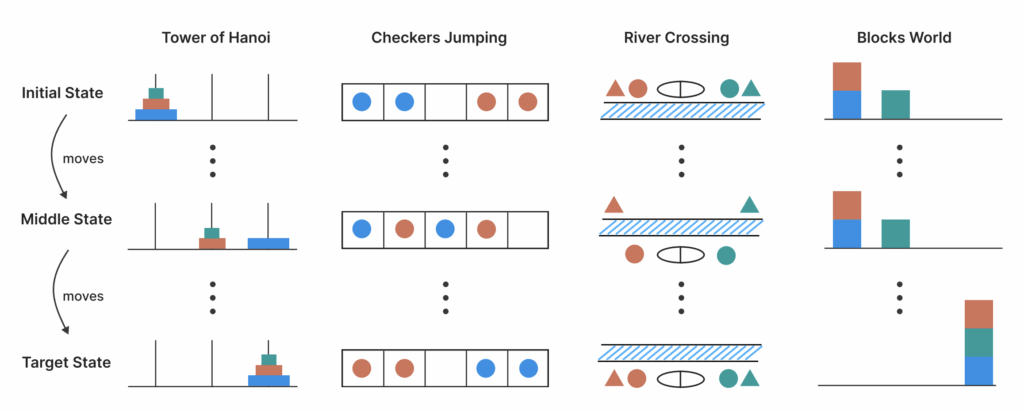
Recent advances in large language models (LLMs) have introduced a new class called Large Reasoning Models (LRMs), which generate detailed thought processes before producing answers. These models, such as OpenAI’s o1/o3, Claude 3.7 Sonnet Thinking, and Gemini Thinking, have shown promising results on reasoning benchmarks. However, their true reasoning capabilities, scaling behavior, and limitations remain unclear. This article summarizes key insights from the paper “The Illusion of Thinking: Understanding the Strengths and Limitations of Reasoning Models via the Lens of Problem Complexity” by Shojaee et al. (Apple), which investigates LRMs using controlled puzzle environments to analyze their reasoning beyond final answer accuracy.
1. Motivation and Background
- Emergence of LRMs: Recent LLMs incorporate “thinking” mechanisms such as long chain-of-thought (CoT) and self-reflection to improve reasoning.
- Evaluation gaps: Existing benchmarks focus on final answer correctness, often suffer from data contamination, and lack insight into internal reasoning quality.
- Key questions: Are LRMs truly reasoning or just pattern matching? How do they scale with problem complexity? How do they compare to standard LLMs with equal compute? What are their fundamental limitations?
The authors argue that controlled environments with manipulable complexity and consistent logical structures are needed to rigorously evaluate LRMs’ reasoning.
2. Experimental Setup: Controlled Puzzle Environments
To overcome limitations of standard benchmarks, the study uses algorithmic puzzle environments with these features:
- Fine-grained complexity control: Puzzle complexity is systematically varied by changing puzzle elements while preserving logic.
- No data contamination: Puzzles rely solely on explicit rules, avoiding memorization.
- Algorithmic reasoning focus: Requires models to apply explicit algorithms.
- Simulator-based evaluation: Enables precise verification of both final answers and intermediate reasoning steps.
An example puzzle is the Tower of Hanoi, where the number of disks controls complexity.
3. Key Findings
3.1 Three Performance Regimes
By comparing LRMs with standard LLMs under equal inference compute, three regimes emerge:
- Low complexity: Standard LLMs outperform LRMs in accuracy and token efficiency.
- Medium complexity: LRMs’ additional “thinking” leads to better accuracy but requires more tokens.
- High complexity: Both LRMs and standard LLMs experience complete accuracy collapse.
3.2 Counterintuitive Reasoning Effort Scaling
- LRMs increase reasoning effort (measured by tokens generated during “thinking”) as complexity rises, but only up to a point.
- Beyond a critical complexity threshold, reasoning effort declines sharply despite having sufficient token budget.
- This suggests a fundamental limit in LRMs’ ability to scale reasoning with problem complexity.
3.3 Limitations in Exact Computation and Algorithm Use
- LRMs fail to consistently apply explicit algorithms across puzzles.
- Reasoning is often inconsistent and error-prone, especially on complex tasks.
- Models do not reliably use exact computation or systematic planning.
3.4 Analysis of Reasoning Traces
- Correct solutions tend to appear early in the reasoning trace for simple puzzles but later for moderate complexity.
- LRMs often “overthink,” exploring many incorrect paths even after finding a correct one.
- In high complexity cases, models frequently fixate on early wrong answers, wasting tokens without self-correction.
- This reveals limited self-reflection and inefficient reasoning patterns.
4. Implications for Reasoning Models
- Questioning current evaluation: Sole reliance on final answer accuracy misses critical insights about reasoning quality.
- Need for controlled testing: Puzzle environments provide a better framework to study reasoning mechanisms.
- Scaling challenges: LRMs face inherent limits in scaling reasoning depth and complexity.
- Design improvements: Future models require better algorithmic reasoning, self-correction, and efficient exploration strategies.
5. Summary of Contributions
- Developed a controlled, contamination-free experimental testbed using algorithmic puzzles.
- Demonstrated that state-of-the-art LRMs fail to generalize problem-solving beyond moderate complexity.
- Identified a surprising scaling limit where reasoning effort decreases despite increasing complexity.
- Extended evaluation beyond final answers to analyze internal reasoning traces and self-correction.
- Provided quantitative evidence of LRMs’ inefficiencies and fundamental reasoning limitations.
6. Visual Insights (From the Paper’s Figures)
- Accuracy vs. Complexity: LRMs outperform standard LLMs only in a mid-range complexity window before collapsing.
- Token Usage: Reasoning tokens increase with complexity initially but drop sharply near collapse.
- Reasoning Trace Patterns: Correct answers emerge early in simple puzzles but late or not at all in complex ones.
- Overthinking Behavior: Models persist in exploring wrong solutions even after identifying correct ones.
7. Conclusion
This study reveals that the “thinking” exhibited by Large Reasoning Models is often an illusion rather than genuine reasoning. While LRMs can improve performance on moderately complex tasks by generating explicit reasoning steps, they fail to scale to higher complexities and do not consistently apply exact algorithms. Their reasoning traces show inefficiencies such as overthinking and fixation on incorrect solutions, indicating limited self-correction.
These findings challenge the view that current LRMs represent a fundamental leap toward general reasoning AI. Instead, they highlight the need for new architectures and training paradigms that better capture true algorithmic reasoning, scalability, and robustness.
References
Shojaee, P., Mirzadeh, I., Alizadeh, K., Horton, M., Bengio, S., & Farajtabar, M. (2024). The Illusion of Thinking: Understanding the Strengths and Limitations of Reasoning Models via the Lens of Problem Complexity. Apple Research. arXiv:2506.06576.
Paper: https://ml-site.cdn-apple.com/papers/the-illusion-of-thinking.pdf
Добавить комментарий